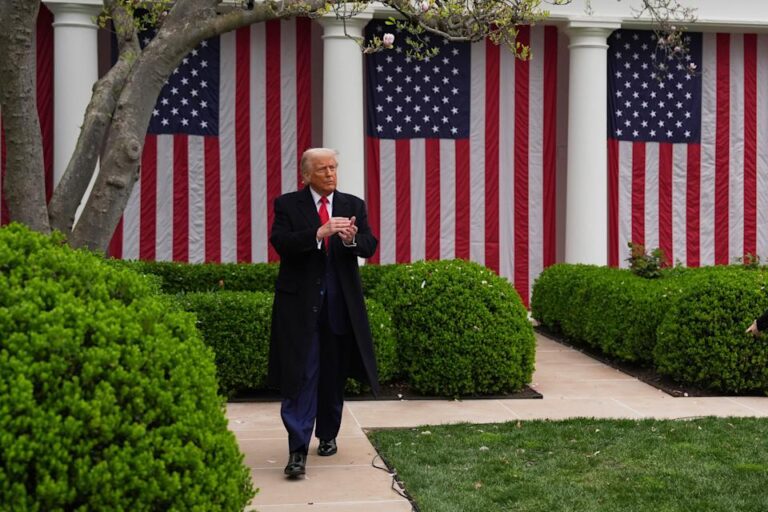TOKYO – As trade negotiations between the United States and Japan unfold in Washington, U.S. President Donald Trump’s well-known desire for a stronger Japanese yen against the dollar is almost certain to be a point of contention. However, analysts caution that any attempts to manipulate the currency exchange rate could carry significant risks for both economic powerhouses.
The initial discussions commenced on Wednesday with Japan’s chief negotiator, Economy Minister Ryosei Akazawa, meeting with U.S. Treasury Secretary Scott Bessent and Trade Representative Jamieson, with a surprise appearance by President Trump himself.
The issue of currency valuation was explicitly placed on the agenda by the White House last month. President Trump accused Tokyo of deliberately weakening the yen, thereby granting Japanese exporters an unfair advantage in trade.
While the yen was not a topic of discussion during Wednesday’s meeting, according to Akazawa, currency matters are traditionally handled by Finance Minister Katsunobu Kato. Kato is scheduled to engage in his own set of talks with Secretary Bessent next week during the International Monetary Fund and World Bank meetings in Washington.
Financial analysts are united in their assessment that any agreement dictating the dollar-yen exchange rate is inherently complex and fraught with potential pitfalls.
Should Tokyo attempt to pressure the Bank of Japan (BOJ) into accelerating interest rate hikes to bolster the yen, it risks stifling Japan’s fragile economic recovery and infringing upon the central bank’s independence.
Alternatively, Japanese authorities could intervene by selling U.S. dollars to buy yen. However, this strategy would necessitate the withdrawal of billions of dollars invested in U.S. debt at a time when global markets are particularly sensitive.
Citigroup analysts have identified Japan as a potential primary target should the Trump administration pursue a coordinated devaluation of the dollar to enhance U.S. global competitiveness – a proposal informally dubbed the “Mar-a-Lago Accord.”
“At this point, we do not see a ‘Mar-a-Lago Accord’ as a concrete risk,” noted Citigroup currency strategist Osamu Takashima in a research briefing. Nevertheless, he added, “countries such as Japan, which have sizeable foreign currency reserves and whose currency is undervalued, would tend to be the target in this case.”
The United States stands as Japan’s largest export market, with automobile shipments accounting for approximately 28% of its exports to the U.S. Japan’s economy is already grappling with the impact of President Trump’s recently imposed 25% tariff on cars. Since the announcement of this tariff on March 26th, the benchmark Nikkei share average has experienced a 6% decline.
While Akazawa provided limited details regarding the initial discussions, he informed reporters that President Trump emphasized that reaching a trade agreement with Japan was a “top priority.”
Echoes of the Plaza Accord?
The yen has already begun to appreciate against the dollar. In mid-2024, the dollar reached a high of nearly 162 yen for the first time since 1986, the period following the Plaza Accord. The Plaza Accord was a 1985 agreement between the U.S., Japan, Britain, Germany, and France at New York’s Plaza Hotel to depreciate the U.S. dollar. The “Mar-a-Lago Accord” is a clear reference to this historical event and President Trump’s Mar-a-Lago resort in Florida.
However, this week saw the dollar dip below 142 yen following a sharp decline driven by concerns that President Trump’s focus on tariffs could trigger a U.S. recession. Furthermore, speculative bets anticipating further strengthening of the yen have reached their highest levels since the Commodity Futures Trading Commission (CFTC) began recording this data in 1986.
Analysts suggest that President Trump and Secretary Bessent should carefully consider the current economic climate before making significant demands for Japan’s assistance in weakening the dollar.
Unlike the situation in 1985 during the Plaza Accord, international investors now hold nearly $15 trillion in U.S. government debt, which has traditionally been viewed as a benchmark for risk-free investment returns. The recent volatility in U.S. Treasuries, partly attributed to Trump’s policies, has cast doubt on this long-held assumption. While some stability has returned to debt markets this week, overall sentiment remains fragile.
“We have to remember that the Treasury Secretary is the head salesperson for U.S. Treasuries,” cautioned Yunosuke Ikeda, Nomura’s Japan head of macro research. “Trying to talk down the dollar would be a very dangerous strategy at the moment, even if Bessent believes in the merits of a weaker currency in the longer term.”
While the yen remains weak by historical standards and Tokyo also desires a stronger currency, Japanese authorities have indicated their preference for bolstering the yen’s value through initiatives such as enhancing industrial competitiveness, rather than direct currency manipulation. This approach may not offer the immediate solution President Trump is seeking.
Furthermore, pressuring the Bank of Japan to accelerate interest rate hikes is also problematic. Rising borrowing costs and inflation are both sensitive issues for voters, particularly with crucial upper house elections looming in July.
“The Japanese side is going to say the BOJ is independent, and they are not trying to manipulate the currency,” stated Shoki Omori, chief desk strategist at Mizuho Securities. “After all, we’re in a tightening cycle.”


Leave a Comment